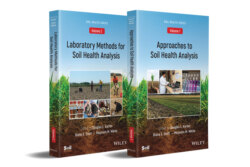Читать книгу Soil Health Analysis, Set - Группа авторов - Страница 43
Scale
ОглавлениеThe scale of measurement is an important consideration for soil health assessments because soil resources can have very different properties when viewed across an individual field, across an entire landscape, as a core representing the soil profile, or as a small sample prepared for one or more analytical measurements. Within‐field variability is another factor that can make soil health assessment useful or futile. For example, changes in SOM could reflect either an increasing level or an unintended over‐sampling from soil series within the field that tend to have higher SOM levels than others. Slope is another common factor in agricultural fields that helps explain differences in SOM (Ladoni et al., 2016; Ontl et al., 2015). Also, if samples are collected from within a row, are the measurements applicable to the entire field or only the 25% of the field that is within a crop row? These questions are relevant not only for SOM but all potential soil health indicators. For example, in a study of carbon dioxide (CO2) flux from no‐till fields, Kaspar and Parkin (2011) estimated each field consisted of 25% rows, 45% untracked inter‐rows, and 30% tracked inter‐rows, thus highlighting the importance of controlling traffic patterns to ensure that only a small portion of each field is disturbed. Quantifying such fine scale variations in soil properties is an important component of soil health assessment since the results may help identify new crop management practices that can improve all functional zones in the soil (Williams et al., 2016).
Figure 3.3 Soil health documentation must recognize inherent (left) and dynamic (right) soil properties. (Photo Credit: Gary Radke, USDA ARS).
